LATEST NEWS FROM OTHER BUILDERS
RETURN TO HOME / INDEX PAGE
- BUILDING RAKU FROM A KIT
- Duflex Kit Construction in 9 Steps

BUILD YOUR RAKU CAT WITH A DuFLEX KIT BY FOLLOWING THESE NINE BASIC STEPS

Step 1. Kit Design
Work with us to finalise the details of the design you have chosen including any design options or additional modules to be included in the kit.
We will determine the laminates, the number of panels required for each laminate, create the cutting files and prepare a quote for the kit if it is not already priced.
Once the design details and pricing are confirmed you are ready to place your order.

Step 2. Unpacking
2. The kit arrives at your workshop door, usually by container, as a stack of 1.2m x 2.4m routed composite panels ready to be joined. The shipment will normally include additional reinforcements, resins, and ancilary products as specified.
Unpack the shipment and stack the panels out of the way of the space where the panels will be joined.
If you have purchased a joined kit many of the panels will already be joined up to the length that can be shipped in a container (12m).

Step 3 Joining the Panels
Set up the work space where the panels are to be joined.
The panels have a scarf join called a Z join that facilitate the join without needing tapes.
The joining can be done with a heated Z press that cures the epoxy join quickly. Alternatively they can be joined with clamping pressure.
If the panel are are being joined with the Z press you will need an elevated work bench the full length of the longest panels you are using. (image below).
If you are joining them with a clamping technique the space can be on the factory floor.
A nesting booklet is provided with the kit to show how the panels are joined (right)

Joining the panels with clamping pressure

Panels are being joined into a single long panel by painting the surfaces of the scarf join with epoxy screwing through plywood battens that have a release film applied to one side.
Joining the panels with the Z Press

Step 4 Stacking Joined Panels
Once the joins are cured the panels are stacked to one side until they are needed for the job. The inividual parts should not be cut free of the panels until they are required.
Bulkhead and floor panels will be needed before the hull sides and cabin top so they should be left to the front of the stack wherever possible.

Step 5. Separating the Parts
When assembly is ready to begin the individual parts are separated from the panels by cutting the joining tabs. It is likely you will be building onto moulded hull bottoms that have been built from strip planking or another method of building moulded components. The process for building moulded components is described in another article.

Step 6. ASSEMBLY
As the joined panels are assembled onto the job you will need to apply glass tapes to the joins as specified in your plans.
Panels can be surfaced and coated inside and out with high build while they are on the workshop floor to minimise fairing time once they are assembled to the boat. The paint on the panels shown here has been kept back from the edges to provide a good bond for the tapes.

Smaller items such as steps, seats and dagger cases are nested into the kit and for the more complex parts diagrams are provided to assist with the assembly process.

Step 7. Interior
Interior kits can be ordered with the primary kit, or they can be ordered later when final decisions have been made about the interior arrangement.
A compromise solution is to order the interior as a set of plain planels that can be cut to shape on site after finalising the layout.

Step 8 Fairing, Painting, Hardware Installation
8. The DuFLEX construction process goes a long way to minising the amount of fairing that has to be done, but inevitably any boat that has not come out of a female mould will require some level of fairing and surface preparation prior to painting.
The fillers and resin systems required for the fairing work are normally supplied as part of the kit.
Hardware installation is the same as for any other form of construction using high density core inserts or consolidated laminate in way of fittings.

Step 9. Sailing
Go Sailing. This Barefoot 40 Catamaran was built entirely with a Duflex kit in Foam/Glass and Epoxy resin systems from ATL Composites

DuFLEX Kits are manufactured and supplied world wide by ATL Composites
atlcomposites.com.au
And in Europe by VDL Composites
www.vonderlinden.de/her/28/vdL-Composites-GmbH
For more information on DuFLEX and associated Products
atlcomposites.com.au/category/27/DuFLEX

Join the Newsletter

- Scroll to top
- FUSION THE SMART CHOICE
- BUILDING YOUR DREAM
- FUSION THE BOAT
- TESTIMONIALS
Construction Flexibilty:
By producing this modern catamaran in modules, which in turn fit in containers, it has meant delivery is simple and it has opened the doors to worldwide marketing of the Fusion 40. The cost savings on overseas shipping as deck cargo, is in excess of $40,000.00. Private contractors are available to assist with assemblies to any stage if you desire.
For more information on this fabulous product, or even where the closest one to you is, please click here to contact us .

Skoota 18 Boat Plans…
$ 130.00

Skoota 18 Boat Plans (SK18)
The Skoota 18 is a simple to build and trail power catamaran.
Description
Additional information.
- Reviews (0)
The Skoota 18 is a simple to build and trail power catamaran. It is based on the Chat 18 sailing catamaran but with extra buoyancy aft to take a bigger engine, up to 20hp. This gives an economic cruising speed around 9-10 knots and top speed in the low teens. The small cuddy offers protection during the day while the boom tent and long cockpit seats mean you can camp on board for a night afloat. The boat is built using conventional stitch and glue plywood, build time is estimated at 300 hours.
Designed by Richard Woods.
Click here to see study plans
Related kits:, marinepoxy kit.
There are no reviews yet.
Your email address will not be published. Required fields are marked *
Your review *
Name *
Email *
Save my name, email, and website in this browser for the next time I comment.
You may also like…

MarinEpoxy-Fiberglass Kit Skoota 18 SK18
- $ 971.60
- Select options
Privacy Overview
These Mahogany hulls come are ready to be and leveled and jigged
working on the interior before the bridgedeck goes on. This allows for easy access
prefit panels for the Bridge deck made with Nida-Core panels
Bridgedeck kit built with Nida - Core is being glued into place
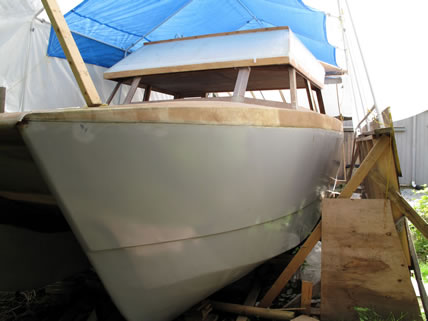
Window design and fitting of new cabin and flybridge
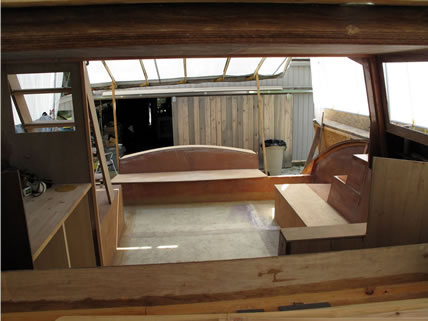
Open concept Interior with aft seating 19 ft Twin Consoled Sportfishing Catamaran
19 ft Catamaran Fishing Sciff built from plans designed by Multihull Boat Building . This catamarans performance is enhanced using a hydrofoil in the tunnel. Increasing performance by 40%, this cat planes at 10kts and has a top speed of 45kts. NV22 Catamaran
- Kit Catamarans
- Commercial cats
- Motorsailing Cats
- Sailing Catamarans
- Power Catamarans
- Tactical Catamarans
- Custom Building
- Boat Repair
- Omer wingsail
- Engineering
- Catamaran For Sale
Multihull Designs - Custom Catamaran Building - Catamaran Kit Boats Custom Composites Designs

Your shopping cart is empty!
Power Catamaran 46 Boat Plan
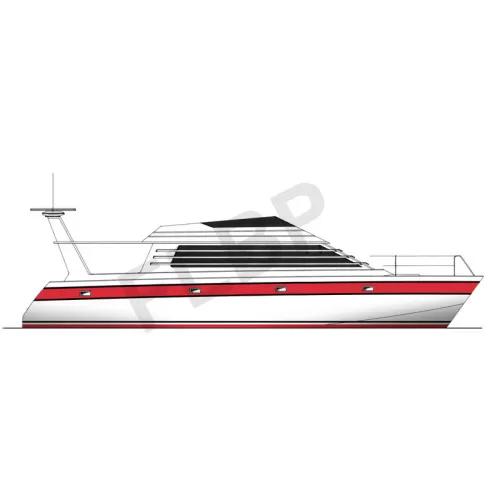
- Description
- Reviews (0)
Roberts Power Catamaran 46
These catamarans, the Cat 39 and Cat 46, were designed to be built using the fibreglass panel construction techniques. The method is very simple to use and very good for the inexperienced builder. Full size patterns are supplied for the female frame formers saving you lofting time and expertise. Special pre-scaled drawings are supplied for each hull panel making it simple for the builder to laminate all of the hull and superstructure on a flat table. The panels are set inside the pre-erected framework and laminated together similar to the plywood 'Stitch and Glue' method.
The study plan package has details of construction techniques and includes a materials list, large scale drawings of the accommodation and general arrangement. material list and more.
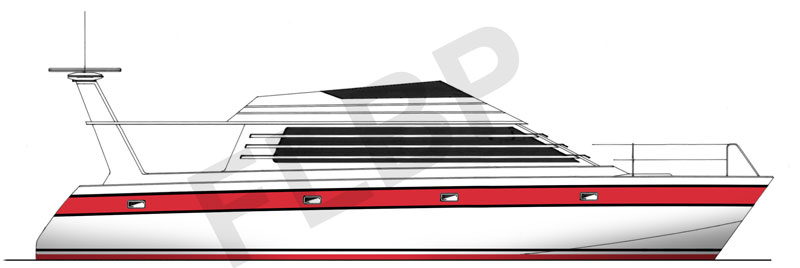
Write a review
- Brand: Bruce Roberts Designs
- Product Code: Power Cat 46
- Availability: In Stock
Prices in Australian Dollars (AUD) SP - Study Plans FPP - Full Plan and Patterns
0 reviews / Write a review
Related Products
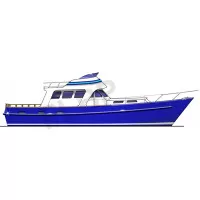
Waverunner 45 Boat Plan
Roberts Waverunner 45 This semi-displacement cruiser can be built as a Charter fishing boat, Fami..
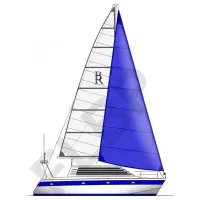
Power Catamaran 39 Boat Plan
Roberts Power Catamaran 39 These catamarans were designed to be built using the fibreglass panel ..

PCF 36-40 (Pacific Coast Fisherman) Boat Plan
Roberts PCF 36-40 (Pacific Coast Fisherman) This design may be built as a motor sailer for family..
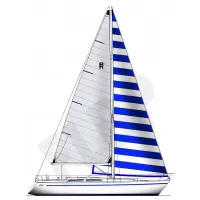
Roberts 434 Boat Plan
Roberts 434 This design has appealed to many serious cruising sailors, and is another in the late..
Tags: plans , power catamaran ,

Service Locator
- Angler Endorsement
- Boat Towing Coverage
- Mechanical Breakdown
- Insurance Requirements in Mexico
- Agreed Hull Value
- Actual Cash Value
- Liability Only
- Insurance Payment Options
- Claims Information
- Towing Service Agreement
- Membership Plans
- Boat Show Tickets
- BoatUS Boats For Sale
- Membership Payment Options
- Consumer Affairs
- Boat Documentation Requirements
- Installation Instructions
- Shipping & Handling Information
- Contact Boat Lettering
- End User Agreement
- Frequently Asked Questions
- Vessel Documentation
- BoatUS Foundation
- Government Affairs
- Powercruisers
- Buying & Selling Advice
- Maintenance
- Tow Vehicles
- Make & Create
- Makeovers & Refitting
- Accessories
- Electronics
- Skills, Tips, Tools
- Spring Preparation
- Winterization
- Boaters’ Rights
- Environment & Clean Water
- Boat Safety
- Navigational Hazards
- Personal Safety
- Batteries & Onboard Power
- Motors, Engines, Propulsion
- Best Day on the Water
- Books & Movies
- Communication & Etiquette
- Contests & Sweepstakes
- Colleges & Tech Schools
- Food, Drink, Entertainment
- New To Boating
- Travel & Destinations
- Watersports
- Anchors & Anchoring
- Boat Handling
The Planing Power Catamaran: A Different Kind Of Cat
Advertisement
Planing powercats deliver the high speeds dayboaters and weekend anglers crave — but without so much pounding in choppy seas.
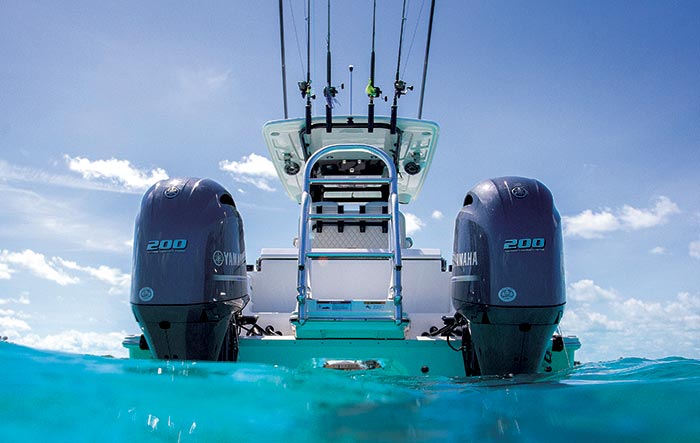
The air cushion created between the two hulls dramatically reduces wave impact at running speeds. (Photo: World Cat)
Powercats are different beasts than sailing cats, and the powercats you're most likely to see on your local waters are those in the 20- to 40-foot range (like my 22-foot Glacier Bay). Unlike the big cruising powercats, which are more like cat trawlers with top ends maybe a little over 20 mph, smaller cats have planing hulls that perform much like today's modern powerboats.
Depending on the engine package, there are a few cats that top out in the lower 30s, lots in the lower 40s, some in the 50s, and a few that break 70 or even 80 mph.
While a similar length monohull may have a 40-mph cruising speed in a 2-foot chop, the monohull captain will pull back the throttles and cruise at 30 to avoid being beaten up. The cat guy, on the other hand, may be able to keep on doing 40 thanks to the smoother ride. But having two hulls underfoot does create some interesting similarities in how these different types of boats react to input from the helm. So you'll see a few of the tips here mirror those used for sailing or cruising catamarans. Whatever type of cat you may be captaining, remember the following:
- Center the wheel and use only the throttles to control the boat. Powercats have their engines exceptionally widely spaced apart, and are far more responsive than monohulls when steered via throttles. Generally speaking, turning the steering wheel will only serve to reduce the effectiveness of working the throttles. This, of course, is assuming you have two engines. There are a few rare cats with one engine.
- At identical rpm, the engine in forward will create more thrust than the engine in reverse. So even if the throttles are set evenly when opposed, the boat will likely slide forward a bit as opposed to spinning in its own length. As a result, when attempting to speed up the maneuver it's usually best to favor giving the reversed engine extra oomph as opposed to the one in forward (assuming you don't want to move forward while turning the boat).
- Check the speed and direction of the wind before docking , and remember that some cats, particularly those with low draft, can be blown around more easily than many monohulls as there may be less hull below the waterline.
- When docking in a new slip for the first time with lines that haven't been preset, bear in mind that once you're docked, securing the boat can be difficult in some situations because few powercats have centered cleats. Most will have a single cleat on either side, in some cases obstructed by a bow rail and/or pulpit, which can make crossing lines difficult.
- Never shut those engines down until all the lines are secured . Again, remember that many cats can get blown out of kilter faster than the average monohull, and if you don't have lines preset, it may take a moment to figure out how to best secure them. Many a captain has done a perfect docking job and then shut off the engines, only for a gust of wind to push the boat right back out of the slip before the lines can be tied. Keep those engines running until the boat is 100% secure so you can apply power, if necessary, to maintain position.
Why Two Hulls?
Like all boats, catamarans come with distinct advantages (smooth ride, draft), and areas of compromise (docking, turning). Regardless of design aesthetics, the first question is usually: Why two hulls?
Mike Myers, vice president of product development for World Cat explains: "Catamaran hulls experience little to no drag or resistance to get on plane, resulting in greater fuel economy. They have a steady rise in speed and fuel burn with little to no spikes in fuel consumption."Planing powercats have a unique trait — which many cat lovers consider the top advantage over monohulls — the impact-absorbing cushion of air created by a compression tunnel between hulls.
And when it comes to beam, catamarans' parallel hulls create reliable stability, which helps to avoid heeling and capsizing, and greatly reduces the vessel roll at rest and at trolling speeds.
"Many boats are primarily designed around comfort for the captain. This usually means anyone at the front or sides of the boat takes most of the jostling,"Myers says. "The catamaran-style hull delivers ride comfort, smoothness, load distribution, and stability."That stability draws anglers to powercats of typically 20 to 40 feet; and cruisers to sailing cats 40 to 60 feet and beyond.
— Rich Armstrong
Taming The Cat
When it comes to handling powercats in open waters, the most important thing to remember is that all boats are different. Just as you wouldn't lump the handling characteristics of all monohulls together, the same goes for powercats. But many have a few common traits to consider.
- Some powercats have relatively low buoyancy in the bow compared to monohulls, as many have very narrow hull entries . As a result, in some cases, idling into a sea can allow waves to break over the bow. Gaining some headway so the bow rises a bit and packs air into the tunnel can alleviate the issue.
- Some planing powercats will run smoother at faster speeds than slower speeds, as they compress air in the tunnel between the two hulls. In these cases, speeding up may actually provide a more comfortable ride in some sea states as compared to slowing down. Depending on your boat, its tunnel may result in other differences from the monohull that you may be familiar with. Learning about these will improve you experience.
- Some powercats display a "snap roll,"which is a very fast righting motion that can rock the boat uncomfortably, especially when drifting in a beam sea. In these cases, people who may want to drift often (such as anglers) will sometimes deploy a drift sock off the bow to reduce rocking and rolling.
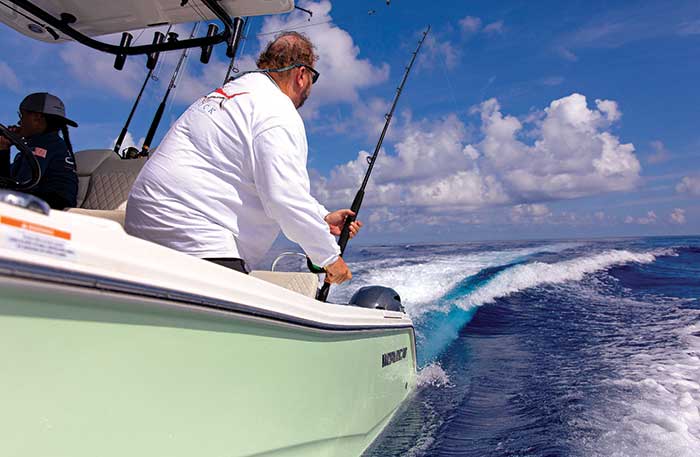
Photo: World Cat
- In general, powercats are often more weight-sensitive than monohulls, especially when the bow is loaded down . It's always best to be aware of how you're loading your boat, and if the tunnel is slapping or the bow is digging into waves, consider shifting weight aft.
- Some powercats, particularly older models, lean out in a turn rather than banking in. There's no way to eliminate this phenomenon (although trimming up an outboard engine when initiating a turn may reduce it a bit), so it's important to give passengers a warning to hold on before making any aggressive maneuvers.
- "Sneezing,"or blowing a puff of mist out the front of the tunnel that the boat then runs through (getting everyone aboard damp), is a phenomenon associated with some powercats. In many cases, trimming the bow up a bit will significantly reduce or even eliminate sneezing.
Related Articles
The truth about ceramic coatings for boats.
Our editor investigates the marketing claims of consumer-grade ceramic coatings.
Fine-Tune Your Side Scan Fishfinder
Take your side-scanning fishfinder off auto mode, and you’ll be spotting your prey from afar in no time
DIY Boat Foam Decking
Closed-cell foam flooring helps make boating more comfortable. Here’s how to install it on your vessel
Click to explore related articles
Lenny Rudow
New Boats, Fishing & Electronics Editor, BoatUS Magazine
Top tech writer and accomplished sports fisherman, BoatUS Magazine Contributing Editor Lenny Rudow has written seven practical boating books, won 30 awards from Boating Writers International — many for his marine electronics articles – and two for excellence from the Outdoor Writers Association of America. He judges the NMMA Innovation Awards, and is Angler in Chief at FishTalk, his own Chesapeake-based publication. A great teacher and inspirational writer, Lenny hosts many of BoatUS Magazine’s very-popular how-to videos, which can be found on the BoatUS YouTube channel, or at BoatUS.com
BoatUS Magazine Is A Benefit Of BoatUS Membership
Membership Benefits Include:
Subscription to the print version of BoatUS Magazine
4% back on purchases from West Marine stores or online at WestMarine.com
Discounts on fuel, transient slips, repairs and more at over 1,200 businesses
Deals on cruises, charters, car rentals, hotel stays and more…
All for only $25/year!
We use cookies to enhance your visit to our website and to improve your experience. By continuing to use our website, you’re agreeing to our cookie policy.

- Testimonials
P: (+61) 02 4981 8288
Disclaimer Copyright © 2013 Spirited Designs. All Rights Reserved.

MIKE WALLER
Yacht design.

WE SPECIALIZE IN BOAT PLANS FOR AMATEUR BUILDERS
We provide stock boat plans for both monohull and multihull sailing vessels, including sailing skiffs and sharpies. Our designs mainly feature timber construction, in plywood or cedar strip plank composite construction, using the W.E.S.T. system (wood epoxy saturation technique). Our designs are intended mainly as cruising boats, although several have done well in racing. All designs are suitable for amateur boat builders.

MONOHULLS
multihulls , photos from our builders.
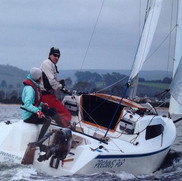
Photo galleries are provided on each design page where available


DIY Cruising Catamaran: Complete Building Guide
As an Amazon Associate, we earn from qualifying purchases. We may also earn commissions if you purchase products from other retailers after clicking on a link from our site.
A brand-new cruising catamaran can set you back a hefty amount of money. However, a DIY cruising catamaran provides a more affordable way to own your own boat. While building a large boat can be an extremely challenging and time-consuming experience, nothing beats the pleasure of bringing your own boat to life.
To build a DIY cruising catamaran, buy good design plans, determine your budget and find a working space. Next, choose your hull material, buy supplies and start building the mast beam. Build and sheathe the hull, install bulkheads, the interior, and finally, launch the catamaran boat.
In this article, you will find a complete guide to building your own catamaran. You will also find detailed information on why you may want to consider building your catamaran and approximately how much this project would cost. Finally, we will explore the advantages and disadvantages of building a catamaran from scratch.
Why You Might Want To Build Your Own Catamaran
Most people might think that purchasing a used boat to repair and fix it up would be cheaper than a DIY cruising catamaran. But while building your own catamaran could be an enormous undertaking, it also comes with many advantages over buying something used.
Other than the unique opportunity to create beautiful memories and experiences while cruising, sailing, and exploring beautiful coastlines, there are a number of benefits that come along with the DIY approach.
Knowing Your Boat
Building your own catamaran provides you with intimate knowledge of your boat. You will know every corner, including where to find every bolt, wire, bulkhead, rib, hose, and support as you installed them yourself. This knowledge will enhance your confidence while at sea since you will have entrusted your life to a boat whose history you are aware of and deeply connected to.
Pride of Ownership
The satisfaction you get from crafting something with your own hands is immense. As a result, the knowledge that you built your boat from scratch will fill you with absolute pride and an immense sense of achievement. Furthermore, as an owner-builder, you get to keep and enjoy the boat for as many years as you wish.
Substantial Cost Savings
Building your catamaran will work out cheaper than buying a new or even gently used boat. Though you will likely require some additional labor since doing some things will require an extra pair of hands, if you are particularly good at DIY, you will save a significant amount of money on labor costs as a whole.
Freedom To Create Your Own Designs
If you decide to buy a catamaran boat, it might not be easy to find one that meets your unique needs. However, instead of choosing from production boats that bear traditional and outdated designs, you can come up with an ultra-modern design or style for your catamaran. You also get to pick your layout, size, and equipment based on your taste and budget.
Great Learning Experience
Building your own boat will help you pick up numerous skills that will come in handy later when sailing your boat. As much as you might still require an expert to help you with specialized skills like carpentry or wiring, your new skills will serve you well. This will also be beneficial when it comes to your boat’s maintenance and fixing things for yourself.
What To Look For in Catamaran Boat Designs
When deciding on the type of catamaran boat to build, you may want to choose a design that’s simple and easy to build. This is because doing so will allow you to spend a shorter time building the boat.
You also need to have a set of requirements to guide you in choosing your design or what you might call an ideal cruising catamaran wish list. This is essential because, ultimately, you want to build a boat that offers outstanding qualities such as:
- Delivers good speed
- Affordable to own and operate
- Agile, strong, and easy to maintain
- Has a high resistance to capsizing
- Great for sailing and cruising
- Delivers a comfortable and easy motion underway
- Good handling ability and high performance under sail
- User-friendly embarking and disembarking
- Provides ample living and accommodation space
- Presents a reasonable resale value
It’s worth noting that, in general, catamaran boats tend to offer a fair resale value mainly because of scarcity and the high price accorded to production models. So, if you build a well-constructed catamaran, you are bound to get a return that’s much higher than the cost of materials upon resale.
It’s also good to consider whether the design you settle on is from an established designer. This is significant because documentation of the building process is just as valuable when it comes to selling the boat.
How Much Would It Cost To Build Your Own Catamaran?
The cost of building your cruising catamaran will depend heavily on the size of the boat you plan to build and the skills you bring to the table. To give you an idea of probable costs, a professionally built 40 foot (12.1 m) long cruising catamaran could go for up to $300,000.
Though building it yourself will undoubtedly be cheaper, most DIY boatbuilders tend to underestimate the expected costs. Your final costs should cover not only the cost of material and equipment but also the labor and time it would take to come up with the final product.
If you were to build a 40-foot (12.1-meter) catamaran, your cost of materials would range between 20-30% of the total cost. Therefore, for $300,000 total, the boat’s materials would range between $60,000 and $90,000. The hull tends to range between 15-35% of the total build. Again, this depends on the finish and furniture.
But before you even start working on the DIY project, you will need to figure out where to do the work. If your home has ample space, then you can opt for a backyard building. But if you live in a small apartment, then you might want to consider renting a small garage at first and then move on to a boatyard later. This is one of the significant costs involved in building your multi-haul.
What You Will Need
To get a clearer picture of how much the entire project would cost, let’s have a look at what else you will need to purchase.
- Good design plans
- Working space
- Ground tackle
- Matting and roving
- Equipment such as the engine, windows, rudders, deck fittings, mast, and rigging
In addition to the above, you also need to install plumbing and electricals. You may also want to consider going electric rather than using diesel. Not only will this drastically reduce your maintenance costs, but you get to use the regenerated power for all of your housing needs while sailing.
Some catamaran boat designs help you save costs by advocating the use of less expensive corpus materials. Most of the material goes directly into making the boat, which means there is hardly any wastage on vacuum bagging . With this method, there are few molds and temporal building forms and fewer fillers to grind off as waste. All these factors reduce the time and cost it takes to build your catamaran boat.
That said, building a boat of any kind is a huge financial undertaking. As such, you still need to have the financial ability to keep building; otherwise, your project will stall or take much longer than anticipated. Instead of enjoying yourself and making memories cruising to faraway lands, you might end up spending all your time building a seemingly never-ending boat.
To reiterate, this project is more of a labor of love, given that it involves a tremendous amount of manual work. Calculating an hourly rate on the time spent building the boat and adding this cost to that of materials may make it seem a very pricey exercise. However, it is vital to understand that your time matters, and every hour you spend working for “free” should be included.
With that in mind, you need to ensure that you are fully devoted to the boat construction project and are sure you want to do it before you begin. Stopping halfway because it seems like too much work would be incredibly costly.
How To Build a Catamaran
When it comes to building a cruising catamaran, you have 3 main options:
- You can buy an old boat and refurbish it.
- Purchase a bare hull plus deck molding for a home-boat building.
- Start from scratch and build everything, including the hull, on your own.
As mentioned above, renovating an existing boat may end up being more costly than starting from scratch. To build a catamaran boat from scratch, follow the below step-by-step guide.
Prepare the Essentials
Before you jump into such a large project, there are several important aspects to consider:
- Buy your plans from an established catamaran designer. You can also get inexpensive, easy-to-build catamaran designs online.
- Get access to a large working space or build a shed . Depending on your climate, you may need to opt for climate control to avoid an excess of moisture in humid areas.
- Decide on your choice of hull material. This could be fiberglass, aluminum, steel, wood, or ferroconcrete.
- Start working on a bill of materials estimate. Include everything that you think you need to get a better idea of the initial costs.
Build the Mast Beam
Using wood and epoxy, cut and glue together the pieces of wood that will form the mast beam. Most of the work at this stage can occur in a garage since it involves building small parts. Still, the work could take up to 4 months, so be prepared to put in long hours.
Build the Boat Hull
Now, it’s time to build the boat’s hull. A catamaran comprises two hulls which are connected with a deck. Below is a short video showing how to build a hull mold:
This work requires a larger facility, so you might need to move out of the garage and into a boatyard. If you don’t have access to a larger workshop, consider building a shed where you can work as you do the construction. Make sure there’s enough room to fit the boat and also allow you to work comfortably. To cover the shed, you can use opaque white tarps.
Sheathe the Hull
Get all the materials you require for this stage in the construction, such as lots of resin, fiberglass, and foam for use in the hull cores. You’ll also require matting and glass roving to sheath the hull .
Sheathing helps to make the hull impervious to water and other marine borers. But first, you need to prepare the hull using a rotary sander. To make it as smooth as possible, use light, sweeping strokes. This is a very dusty task so be prepared to wear a facemask and safety goggles.
Install the Bulkheads
Next is installing the plywood bulkheads . You might need to call in friends to help turn the hulls or use a crane. In this step, you will need to laminate the hull sides on the molded hull panels and bond them above the bulkheads. Ensure the bulkheads are snug and sealed in place.
Construct the Interior Structure
Over the next couple of months, the boat work will involve joining the hulls together with the beams that you had made back in the garage. Then, install the cuddy cabin, decks , and the cockpit . Soon the boat will start to take the shape of a catamaran.
Next, proceed to construct the major structural components such as stairs, hatches, mini-keels, and the interior. Then comes the work of fairing the boat, which is quite labor-intensive.
Finally, it’s time to apply primer on the catamaran boat and start the paintwork. Before painting the boat, you will need to do additional sanding to finish off the two layers of primer as well as fill all the pinholes. Since it’s a large boat, the catamaran has lots of surface area; thus, the sanding could get extremely exhausting—mentally and physically—at this point.
The painting can take a while, too. The hulls are the easiest to paint, but the topsides, non-skid, as well as masking and prepping could seem never-ending.
The final stretch involves working on the center bridge deck cabin and other final touches like installing the engines, electricals, and plumbing. This is also the time to fix the rudders, rigging, mast, windows, and deck fittings.
Launch Your Cruising Catamaran
After many months or years of hard work, your cruising catamaran is finally ready to test the waters. After lowering the boat into the water, check carefully in case there are leaks. If none, you can set up the sails and take your catamaran out for your first cruise.
Below is a short video that takes you through the entire boat-building process:
If you don’t have deep pockets, don’t despair. It’s also possible to build an inexpensive catamaran boat, as shown in this post from the coastal passage .
The Pros of Building a Catamaran
Though it will be a costly endeavor, there are so many things to look forward to should you decide to build your own catamaran:
- It can be lots of fun.
- You get to have a new boat.
- It’s an excellent hobby for DIY enthusiasts.
- The effort is rewarding.
- It offers a great learning experience.
- You get the exact kind of boat you want.
- You can alter building plans and tailor the boat to suit your specific needs.
- It might be cheaper than buying a new boat.
The Cons of Building a Catamaran
Though there are a number of positive aspects to a DIY build, it is just as important to keep in mind that it won’t always be easy:
- Maintenance costs can be quite high.
- It’s both mentally and physically exhausting.
- It might require some technical know-how.
- It can take many months or even years to complete.
- It requires a lot of commitment to finish the DIY project.
- It might be challenging as well as expensive to get insurance.
- You will spend almost all your free time building the boat.
DIY Cruising Catamaran Tips and Tricks
If you are new to boat building, it would be a good idea to build a small boat first. This would give you a good indication as to whether you’d enjoy tackling a more extensive project like building a catamaran. Again, if you are the handy type, fixing your own electronics could also save you a significant amount of money.
Here are more tips and tricks to get the most out of your DIY cruising catamaran:
- Lower your costs. Bring down your costs even further by sourcing for parts and supplies at marine surplus outlets, Craigslist, eBay, or wholesale suppliers.
- Enhance your resale value. Most home-built boats are not easy to sell since they tend to be too customized. To enhance your resale value, it’s advisable to work with a standard design from a well-established naval architect.
- Follow the design instructions. Make sure to follow the designer’s instructions regarding the type of materials and tools to use during the build to avoid making costly mistakes.
- Maintain your original budget. Avoid any additional customizations once you have started building the boat. Using good plans and sticking to them ensures that your budget doesn’t spiral out of control.
Final Thoughts
Building a catamaran is about more than saving money. It’s fun, exciting, fulfilling, and can be a great learning experience. While it might take many months of back-breaking work, comparative shopping and sourcing for materials will help you save a lot of money. Still, at the end of it all, you’ll have a beautiful catamaran boat, all ready for your first cruising adventure.
However, if you have neither the time nor the energy to build your own catamaran from scratch, refurbishing an existing hull might prove faster and easier. It also works out much cheaper than buying a new boat.
Owner of CatamaranFreedom.com. A minimalist that has lived in a caravan in Sweden, 35ft Monohull in the Bahamas, and right now in his self-built Van. He just started the next adventure, to circumnavigate the world on a Catamaran!
One thought on “ DIY Cruising Catamaran: Complete Building Guide ”
Hello, I am a French Quebecer who is original, imaginative, creative and who finds that all boats and catamarans have a huge flaw and a very big lack of logic. I would have a brand new concept…. I am sending this message to any catamaran creator – designer to make those who have the opportunity and the intelligence to want to know about my innovative idea which will finally upset the market much richer. An idea that will totally change the concept of sailing, navigation and save so much worry!! All I would ask for is a small percentage of each sale of the new product. To be able to make me produce one when I have enough!! It is certain that like that, you just want to tell me: come on Mr. Lessard give us your idea but do not take your word to help me in return! But, if you are the kind of man to have only one word and maybe have a proof of your good faith if the realization of the project would make it… I will be very happy!! Giving it to everyone wouldn’t bother me either…. all I would like is to be able to find flax fiber (too expensive carbon) to be able to try to make my catamaran myself. Because not rich! Have a nice day and looking forward to having a message!!
Leave a Reply Cancel reply
Your email address will not be published. Required fields are marked *
Save my name and email in this browser for the next time I comment.
Recent Posts
Must-Have Boat Gear for Catamaran Sailors!
Sailing is probably the most gear-intensive activity I've ever done; there are so many decisions to be made about what gear to buy now, for tomorrow, and what to definitely never buy. The gear on...
6 Best Trailerable Trimarans For Bluewater and Coastal Sailing
Having a boat costs a lot of money, even when you are not using it, marina fees, etc. And once it is in the water most sailors never go very far from their "home marina" and sailing will be somewhat...
[email protected]

Category: Our Catamaran Build Kits
Recommended equipment.

Quality suppliers & manufacturers
The schionning team have a lot of contact with equipment suppliers and manufacturers, and hear feedback on certain brands or systems from our many customers. there are many schionnings cruising the world and testing products longevity and the customer service offered by the manufacturer., on this page we will list products and companies that we know to provide above average quality and service. it is always growing, and if your company provides equipment used on our designs and you would like to be included - please contact us., engines & drive systems.

Visit: https://oceanvolt.com
Batteries, Power Management

LITHIUM POWER (VIC)
Back in 2013 I knew that my boat batteries were reaching the end of their lives, I had been researching LiFePO4 cells for a few years and decided that I should install them. Unfortunatly I was unable to find a local supplier. So Lithium Power was established.
Technical Information
The technical information page is a collection of documents (mostly in pdf format) on the materials and systems used in schionning catamarans. including data sheets, engineering information, strength comparisons of each core material and informative articles from jeff outling the design of certain system such as engine choices and main sheet systems., detailed engineering data for your research, we understand that getting your head around the process of building your own boat, or having one built, can take a little while. to gain a greater understanding of the materials used in our designs, the below data sheets have been supplied by atl composites, and contain all of the technical data you could need regarding the composites we use. in addition are articles or documents written by jeff about certain systems used on our designs and why., all technical information and data sheets on west system/duflex/durakore provided courtesy of atl composites. for more information please see the atl composites website here., documents library.
Information Sheet – CE CERTIFICATION PROCESS
- Mainsheet Systems for Catamarans
- Motor Choices for Schionning Designs
- Weight and Weight Distribution Schionning Designs
- Schionning Designs Sailing Performance and Tips
- Hull Shapes and Performance – Power Designs
- Outboard Engines VS Diesels – Written by Ross McCombe
- An Outboard Installation That Works – Ross McCombe Follow up
- Data Sheet – DUFLEX BALSA for Catamaran Kit Builds
- Data Sheet – DUFLEX FOAM
- Data Sheet – FEATHERLIGHT Paper Honeycomb
- Data Sheet – WEST SYSTEM R105
- Data Sheet – PUMP SYSTEMS
- Data Sheet – MICROFIBRE BLEND 403
- Data Sheet – MICROLIGHT 410
- Data Sheet – MICROSPHERES 411
- Information Sheet – USING FILLERS
- Data Sheet – KINETIX RESIN Thixotropic
- Information Sheet – DURAKORE PLANKS 413
- Data Sheet – DURAKORE PLANKING 414
Kit Materials Contents
Kit materials' contents, so if you order a schionning kit, what exactly is going to arrive see an overview of the materials you will receive, and what each is used for during the build process. fibreglass cloth or tapes microspheres, microballoons or microfibers take a closer look and you can answer these questions., our schionning kits are a no nonsense, common-sense approach to building a boat. we offer great service, fast delivery and access to anything you could need for your boat straight from the supplier to your door. our construction plans and kits are sold with 100% professional boatbuilder support via phone and email, any time you're unsure or just need a second opinion, we're here..
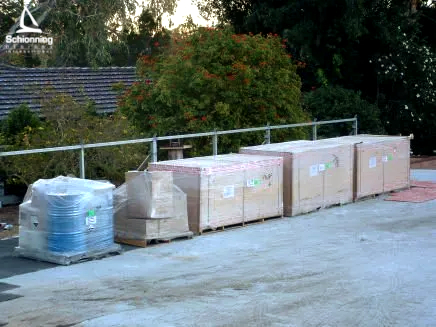
Our kits contain all of your basic materials to build your boat to a faired shell stage, ready for painting and fit-out. We have sail-away costing estimates available for all of our standard designs, and this will give you an accurate idea of the overall cost of your project. This costing varies depending on your level of finish, as you can imagine different options vary greatly in price.
Below is a quick glance at what your Schionning Kit will include and what each item is primarily used for, we hope this is helpful and if you should require more detailed information please don’t hesitate to contact our office.
What do I actually receive?
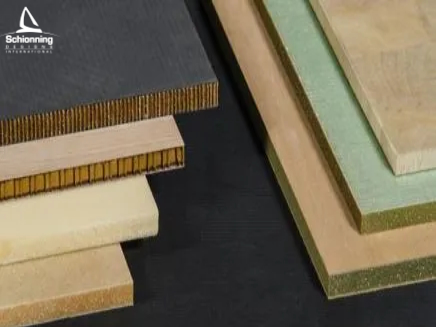
DUFLEX PRE-LAMINATED PANELS
DuFlex pre-laminated panels are the main and most important material used in our kits, predominantly in the flat panel designs, however they are used in Strip-planked designs also, though to a lesser extent. These panels are 2400mm x 1200mm and are CNC routed to speed up build time on our Wildernes X Series, as well as some of our power designs. For internal furniture, a paper honeycomb core is used instead of the end-grain balsa wood core that is used for main structural areas. The use of this is purely to save weight in the shell and therefore produce a faster, more responsive catamaran.

KINETIX LAMINATING RESIN & HARDENER

WEST SYSTEM EPOXY RESINS

FIBREGLASS TAPES (DOUBLE BIAS)
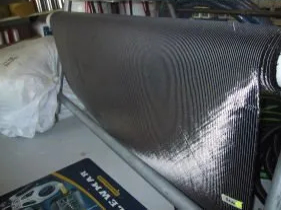
CARBON FIBRE CLOTH

FIBREGLASS CLOTH
The kit process, building your own boat can be a daunting prospect, however to demonstrate each step in the kit assembly process, we've created this guide for you to study. as you can see our kits are the ultimate in building efficiency and have been streamlined over 30+ years to ensure that you're on the water faster and with less effort., how does it all go together.
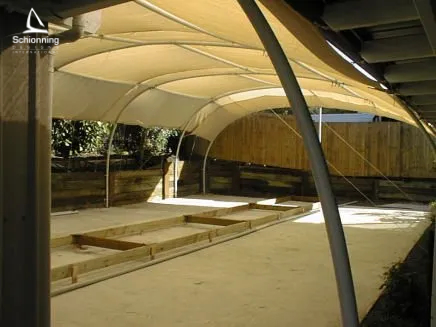
The first step to building your dream catamaran begins with a strongback – this is a square frame used to position the temporary frames that will be used to form the hull shape. This frame will be set up and must be square and accurate, a string or laser level can be used to achieve this.

The forebeam is now installed along with the striker attachment fitting, as shown above. The bridgedeck is installed shortly after and taped onto the bulkheads with webs installed, this now completes what is a quite stiff and strong platform to work on.

Now that the bridgedeck is in place, the forward webs and dash will be fitted. At this stage, all furniture and internal work begins, with the main panels left off for ease of access when working.
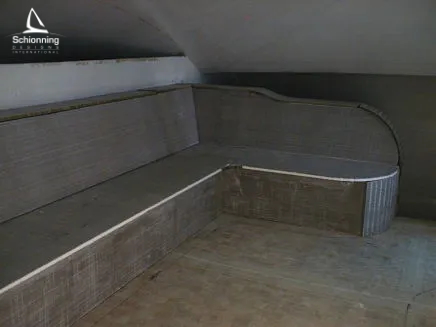
Material Choices
Schionning material choices, solutions that work best for catamarans & why, our designs are based on cored composite construction techniques using west system epoxy resin and knitted fabrics. but given the range of today's composite technologies, which solution works best for catamarans and why written by jeff schionning, selecting the correct materials, resin choices.

It also fully protects the boat against water absorption and it can not develop the dreaded Osmosis.
We choose ATL Composite’s resin systems for their superior quality, reliability and value for money.
Having worked closely with the ATL Composites team and their products for many years, we know we can stand by their material solutions, and rely on great service should something unexpected happen.

This may not seem important but when working with a material for an extended period of time, the small things make all the difference.
CORES Which One to Use?

- End-Grain Balsa – 150kg per cubic metre
- Superlight Balsa – 94kg per cubic metre
- Western Red Cedar – 360-380kg per cubic metre
- Foam – 80kg per cubic metre
BALSA END GRAIN (150 kg/cubic metre)
Balsa has very good values and we can produce a shell using a very light laminate. It will be very stiff and very resilient to fatigue.
It has exceptional qualities including very high compression strength, extremely good sheer capabilities and fantastic sheer stiffness.
Compressive strength is the resistance to collapsing when pressure is applied perpendicular to the surface as when pushing directly onto the material with the point of your finger. Balsa is far stronger than Foam (80kg/cubic metre) in compression.
Balsa is also very strong in shear. This is when the core sample is held flat between your hands, one hand slid one way and the other slid the opposite way, when the core tears through the middle the core has failed in sheer. The amount of stretch you feel before the core shears is shear stiffness. To compensate for sheer weakness the core is made thicker. So 13mm Balsa may be equal in sheer to 19mm Foam.
(80 to 200 kg/m³)
There are many boats sailing that are built from foam as it’s mechanical properties are good for boat building.
- Initially one would expect this cat shell to be lighter as it is ½ the weight of Balsa. We do have to compensate for its weaknesses and will then add to the reinforcement the reinforcement on the outside to spread that compression load over more core and need a triaxial type weave to compensate for the veneer content that runs fore and aft on the Durakore.
- Secondly, we need to increase the Core thickness to compensate for the shear value, usually neutralizing the weight advantage.
- We only use structural foam core that is closed-cell and cross-linked.
The end result using foam core amounts to a very similar total boat weight. Professional builders can achieve a good result but usually use vacuum bagging and very good molds to achieve this.
Secondary Issues
Balsa can absorb water. It needs extreme neglect to rot (very unusual). Water soaks along the end grain quickly. It travels very slowly across the grain. We use balsa under the waterline especially because of it’s high compression strength for beaching etc. any core type must be sealed. Damage to all cores results in the same sort of repair. Notice a damp spot remaining when drying out to anti-foul… simply grind back the surface glass exposing the core, dry it out and re-glass – it’s that easy.
Timber cores are cheaper than Foam in most cases.
A light, high tech cat returns a far better (often 2 – 3 times) re-sale than lower tech materials. Often saving $10,000 on materials initially, loses $200,000 on re-sale – a serious reality.
Our boats can be built using Balsa, Foam or Western Red Cedar. Combine strength, stiffness, lightness and cost, with ease of use – it just makes good sense!

COMMENTS
POWER CATAMARAN PLANS and KITS, CATAMARAN PLANS , Bruce Roberts WEB SITE offers catamaran boat plans and catamaran boat kits for fiberglasss and aluminum boat designs, cut to size CATAMARAN kits, part built boats or complete boats. Bruce Roberts Yacht Designs offer boat building project management arrangements for boats built overseas at affordable prices.
Plans & Kits. Popular Fishing Boat Plans; Power Boat Plans. ... Skoota 20, a folding power catamaran. Add to cart; Skoota 24 Boat Plans (SK24) $ 480.00; 24' power catamaran, folding; Add to cart; Skoota 28 Boat Plans (SK28) $ 1,275.00; 28' power catamaran with cabin, disassemble for towing.
POWER CATAMARAN PLANS and KITS, CATAMARAN PLANS , Bruce Roberts WEB SITE offers catamaran boat plans and catamaran boat kits for fiberglasss and aluminum boat designs, cut to size CATAMARAN kits, part built boats or complete boats. Bruce Roberts Yacht Designs offer boat building project management arrangements for boats built overseas at affordable prices.
We design world renown sailing catamarans, trimarans and power cats. Contact us to purchase building kits and plans or to find the right professionals and resources to bring your project to life.
Availability: The ECO 55 power catamaran is an affordable DIY power catamaran. As the owner proved the boat is a capable coastal cruiser. The inside layout is the same as for the ECO55 sail version but the underwater shape is changed. The cockpit is wider and has a size of 1,45m x 2 m. With the bigger size normal deck chairs can be used.
Step 1. Kit Design. Work with us to finalise the details of the design you have chosen including any design options or additional modules to be included in the kit. We will determine the laminates, the number of panels required for each laminate, create the cutting files and prepare a quote for the kit if it is not already priced.
The Fusion 40 "Kit Cat" is revolutionising the boatbuilding industry. This vessel has been designed from the beginning as a high performance cruising catamaran that can be stacked into 40 foot containers and freighted anywhere in the world. This photograph shows the infusion moulded components as they would appear when removed from the container.
SPIRITED 400 'Power'. The Spirited 400 'Power' is a semi-displacement power cat with sleek lines and light weight structure. For those who like 'turn-key' cruising this highly efficient design is always in readiness for a quick getaway. The slim hulls run easily through the water and provide a very comfortable ride even in rough conditions.
Plans and Kits. Powerboats. Outboards. Hell Cat. Hell Cat. SKU: G-556. $149.00 - $669.00 ) UPC: Current Stock: ... a 16' smooth riding power catamaran A word about power catamarans. The HELL CAT features a very large cockpit with plenty of room to haul diving gear, passengers, etc. As with all the cats, the optimum word is comfort with the ...
The Skoota 18 is a simple to build and trail power catamaran. It is based on the Chat 18 sailing catamaran but with extra buoyancy aft to take a bigger engine, up to 20hp. This gives an economic cruising speed around 9-10 knots and top speed in the low teens. The small cuddy offers protection during the day while the boom tent and long cockpit ...
The ECO 75 power cat is the big brother of the ECO power cat. Designed along the same lines and with the same philosophy. Easy to build boat by an amateur. Construction is the time proven plywood/glass fiber/Epoxy composite system. Nothing can match this system for weight, costs and easy of construction. Besides this advantages no maintenance ...
Plans and Kits. Powerboats. Outboards. Bear-Cat Sport. Bear-Cat Sport. SKU: G-005 $15.00 - $ ... a 25½' X 10' open-cockpit power catamaran. For a PDF study plan download, click HERE. CATEGORY: Power Catamarans CONSTRUCTION: Sheet plywood/wood framing, or welded aluminum.
Kit Catamarans. detailed plans - assembly manual -composite hulls - bulkheads - bridgedeck and deck panels - hydrofoil system. Click here to see the contents of $60,000 30ft Power Catamaran Kit. Catamaran Plans. Catamaran plans for sale includes easy to follow manual - detailed drawings - huge photo photo gallery of how to build - material list ...
These catamarans, the Cat 39 and Cat 46, were designed to be built using the fibreglass panel construction techniques. The method is very simple to use and very good for the inexperienced builder. Full size patterns are supplied for the female frame formers saving you lofting time and expertise. Special pre-scaled drawings are supplied for each ...
SPIRITED 230 'Power'. The Spirited 230 'Power' is a very compact design for camping style cruising with accessibility to some of the best cruising grounds by road! This is a trailerable planing hull power cat but because of the use of a light-weight sandwich flat panel kit it is much lighter than your average production cat of this style ...
Catamaran Stock Plans. ... Plans are leased to build ONE boat, NO time limit. Tri-Star designs are proven designs, sailing the seven seas since 1964. Free consultation is provided to the original non-professional builder till he or she is sailing the seven seas. All boats may be built with flared hulls, with the exception of the TRI 25, TRI ...
This usually means anyone at the front or sides of the boat takes most of the jostling,"Myers says. "The catamaran-style hull delivers ride comfort, smoothness, load distribution, and stability."That stability draws anglers to powercats of typically 20 to 40 feet; and cruisers to sailing cats 40 to 60 feet and beyond. — Rich Armstrong.
We help you create your own dream catamaran with clever and accurate kit packages. Kit boats that deliver exciting performance, full customisation and a sophisticated modern look. ... DIY Boat Building Plans | Kits Australia by Spirited Designs. Home; About; Designs; Kits; Production; ... Synergy 38 RaceLine 380 Spirited 380 Spirited 480. POWER ...
YACHT DESIGN. We provide stock boat plans for both monohull and multihull sailing vessels, including sailing skiffs and sharpies. Our designs mainly feature timber construction, in plywood or cedar strip plank composite construction, using the W.E.S.T. system (wood epoxy saturation technique). Our designs are intended mainly as cruising boats ...
Leaders in Multihull Design & Kit Development The best Advanced Kit Build System in the World. We aim to provide plans and materials of the highest possible standard with "service" being our priority both in supply and backup support to our builders. In design we aim to make your project simple, safe, and as much
If you were to build a 40-foot (12.1-meter) catamaran, your cost of materials would range between 20-30% of the total cost. Therefore, for $300,000 total, the boat's materials would range between $60,000 and $90,000. The hull tends to range between 15-35% of the total build.
POWER CATAMARAN PLANS and KITS, CATAMARAN PLANS , Bruce Roberts WEB SITE offers catamaran boat plans and catamaran boat kits for fiberglasss and aluminum boat designs, cut to size CATAMARAN kits, part built boats or complete boats. Bruce Roberts Yacht Designs offer boat building project management arrangements for boats built overseas at affordable prices.
LITHIUM POWER (VIC) ... Our construction plans and kits are sold with 100% professional boatbuilder support via phone and email, any time you're unsure or just need a second opinion, we're here. ... Schionning Designs supply a list of the Kit Materials you will receive to start the process., catamaran-build-kit-materials, catamarandesign, ...